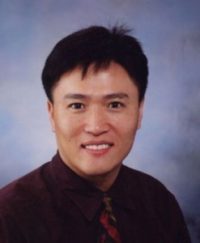Therapeutic Potential of VEGF Blockade in HHT Pathogenesis

Cure HHT is pleased to announce that S. Paul Oh, Ph.D. from the University of Florida has been awarded a $50,000 grant for his research entitled “Therapeutic Potential of VEGF Blockade in HHT Pathogenesis”.
Dr. Oh’s Cure HHT seed grant has been leveraged to $1.1MM through NIH
Proposed Research Study
Why and how do the reduced levels of ENG or ALK1 cause the formation of abnormal blood vessels in HHT patients remains elusive? Dr. Oh’s lab developed mouse models that display remarkably similar pathological features of HHT. These animal models are very useful not only to study mechanisms underlying the HHT pathology, but also to test therapeutic potential of a putative drug for HHT before it is used for patients.
The drug (Avastin) blocks a protein (VEGF) that advances the development of artery formation, called angiogenesis. It is Dr. Oh’s hypothesis that subjects with HHT produce more of this VEGF protein, and that this continued promotion of vessel development is key to the expression of the multiple defects. This would provide much needed additional insight to advance this particular drug for HHT therapeutic options (and perhaps warn us of potential risks). In addition, this study will investigate the relevance of this parameter in the disease process, give us disease understanding, and outline potential alternative targets for treatment pathways.
Research Study Update
“With Cure HHT’s seed grant, I have received a $1.1 million NIH funding for next four years to test efficiency of Tranexemic acid, Thalidomide, and VEGF-trap for skin AVM and GI AVMS, using our animal models. I also received a small financial support from the Korean government for testing six anti-angiogenic small molecules approved by FDA. I will work hard to bring forth novel, safe, and effective therapies for HHT,” stated Dr. Oh.
Only selective vascular beds in a HHT patient develop telangiectasis or AVM lesions, i.e majority of blood vessels of the patient remains normal. Therefore, it has been postulated that local physiological (or environmental) factors (or second hits) in addition to the genetic predisposition by ENG or ALK1 mutations, must be involved in the development of vascular lesions in HHT patients. Using a mouse model system, Dr. Oh has shown that Alk1-deletion induced AVM formations in subdermal blood vessels only in the area where a wound was inflicted. This was the first experimental in vivo evidence demonstrating that a local second hit is indeed essential for the development of de novo AVMs in HHT. This result suggesting that AVM formation requires both genetic (e.g. Alk1 mutation) and environmental (e.g. wound) factors implies that either compensation of the ALK1-deficiency or inhibition of a crucial mediator of the second hit can prevent de novo AVM formation. For the development of therapeutics for HHT, therefore, defining the characters of second hits and identifying crucial mediators of the second hit are of great importance.
Based on Dr. Oh’s previous result showing that wound is an effective second hit for skin AVM formation in the animal model, he has been trying to address for the following two questions:
1. What molecular pathways can mimic ‘wound’?
Dr. Oh’s research showed that both VEGF and lipopolysccharide (LPS) could induce AVM, suggesting that both inflammation and angiogenesis (new blood vessel formation) can function as a second hit. This result implies that not only anti-angiogenic therapy but also anti-inflammation therapy could be an effective AVM preventing therapy.
2. What can prevent the wound-induced AVM induction?
Dr. Oh is focused on anti-angiogenic therapy. Several anecdotal evidence suggesting that anti-angiogenic drugs, such as thalidomide and Bevacizumab (Avastin; anti-VEGF antibody), have shown to be effective in treating epistaxis and liver AVMs. Perhaps the effects of these anti-angiogenic therapies might have come from blocking active angiogenesis, an essential second hit of ALK1-deficiency for AVM development. Dr. Oh observed that both VEGF-Trap and mAB(G6-31) lessened wound-induced AVM formation. Severity of GI bleeding and uterine AVM formation were also decreased in these VEGF blocker-treated Alk1-deficient mice.
